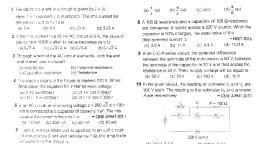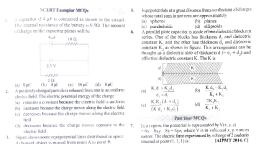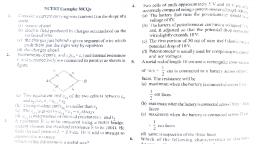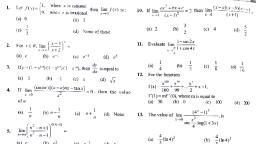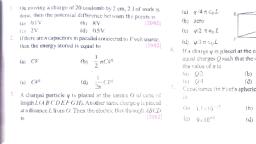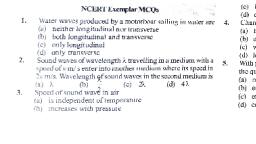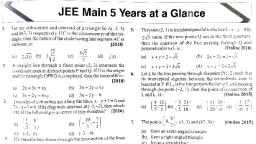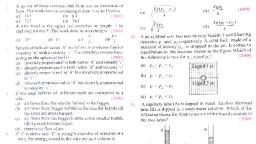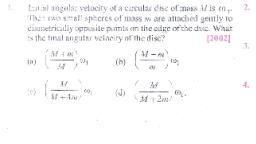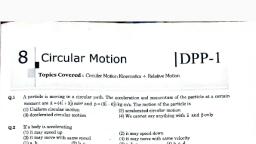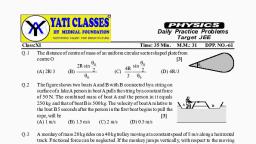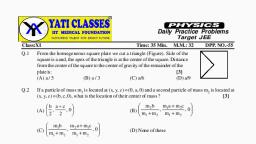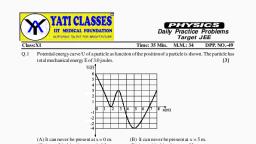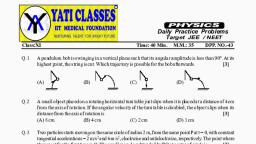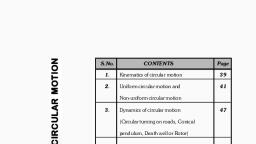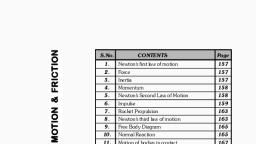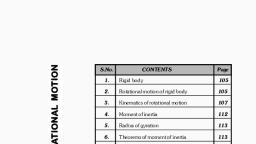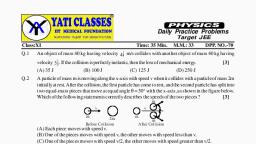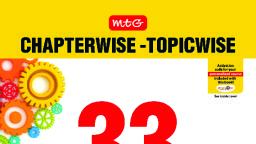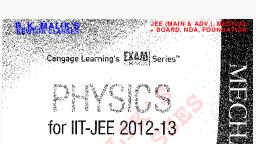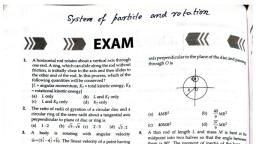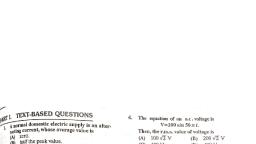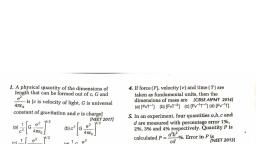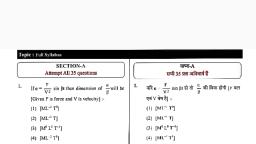Page 1 :
PHYSICS, , Daily Practice Problems, Class:XI, , Discussion: 24-25/08/2015 Time: 35 Min., , Target JEE, M.M.: 30, DPP. NO.-58, , Q.1, , Two bodies with masses m1 and m2 are both moving east with velocities of magnitudes v1 and v2, where, v1 is less than v2. The magnitude of the velocity of the center of mass of this system of two bodies is [3], (A) less than v1, (B) equal to the average of v1 and v2, (C) greater than v1 and less than v2, (D) greater than v2, , Q.2, , A wire of mass m and length is lying on the horizontal surface. It is turned into semicircular wire as, shown & made in vertical plane. Height of centre of mass from ground will be, [3], , (A) L, Q.3, , Q.5, , 2L, 2, , (D), , L, 2 2, , 3mu 2, (B), 4, , (C) mu2, , mu 2, (D), 3, , Two masses of 1 gm and 4 gm are moving with equal kinetic energies. The ratio of the magnitudes of, their linear momentum is, [3], (B), , 2 :1, , (C) 1 : 2, , (D) 1 : 16, , A mortar fires a bomb of mass M at an angle with initial speed v0. The bomb explodes at the top of, trajectory and breaks into two equal bombsAand B. BombAlands close to the mortar. In the same time, bomb B lands away from the mortar. The ratio of speed of bomb A to that of bomb B just after the, explosion at the top is, [3], (A) 3, , Q.7, , (C), , , The momentum of a particle is given by P ( 4 sin t î 4 cos tˆj) kg m/s. Select the correct alternative(s)., [3], (A) Momentum P of the particle is always parallel to F., (B) Momentum P of the particle is always perpendicular to F., (C) Direction of momentum P is always perpendicular to F., (D) None of the above., , (A) 4 : 1, Q.6, , 2L, , , A man is standing on a cart of mass double the mass of that man. Initially cart is at, rest. Now man jumps horizontally with relative velocity‘u’ with respect to cart. Then, work done by internal forces of the man during the process of jumping will be:[3], 1, (A) mu2, 2, , Q.4, , (B), , (B), , 1, 3, , (C) 3cos, , (D), , 1, cos, 3, , A man of 80 kg attempts to jump from the small boat of mass 40 kg on to the shore. He can generate a, relative velocity of 6 m/s between him and boat. His velocity towards shore is, [3], (A) 2 m/s, (B) 3 m/s., (C) 4 m/s, (D) 8 m/s, , PAGE # 1
Page 2 :
Q.8, , Abody of mass M moves in outer space with velocityV. It is desired to break the body into two parts so, that the mass of one part is one-tenth of the total mass.After the explosion, the heavier part comes to rest, whilethelighterpartcontinuestomoveintheoriginaldirectionofmotion.Thevelocityofthesmallpartwill be, [3], (A) V, (B) (V/2), (C) (V/10), (D) 10V, , Q.9, , Two paticles of mass m, constrained to move along the circumference of a, smooth circular hoop of equal mass m, are initially located at opposite, ends of a diameter and given equal velocities v0 shown in the figure. The, entire arrangement is located in gravity free space. Their relative velocity, just before collision is, [3], (A), , Q.10, , 1, 3, , v0, , (B), , 3, v, 2 0, , (C), , 2, 3, , v0, , (D) none of these, , A particle of mass 4m which is at rest explodes into four equal fragments., All 4 fragments are scattered in the same horizontal plane. Three, fragments are found to move with velocity V each as shown in the fig., The total energy released in the process of explosion is, [3], 2, 2, (A) mV (3-2), (B) mV (3-2)/2, 2, (C) 2mV, (D) mV2(1+2)/2, , PAGE # 2
Page 3 :
PHYSICS, , Daily Practice Problems, Class:XI, , Discussion: 26-27/08/2015 Time: 35 Min., , Target JEE, M.M.: 30, DPP. NO.-59, , Q.1, , Figure shows a boy on a horizontal platformAon a smooth horizontal surface,, holding a rope attached to a box B. Boy pulls the rope with a constant force of, 50 Nt. The combined mass of platformAand boy is 250kg and that of box B is, 500kg. The velocity of A relative to the box B 5s after the boy onA begins to, pull the rope, will be:, [3], (A) 1 m/s, (B) 1.5 m/s, (C) 2 m/s, (D) 0.5 m/s, , Q.2, , A cannon is mounted on a trolley initially at rest. A cannon ball is fired at an angle and velocity vrel, relative to trolley which is free to recoil frictionlessly on a smooth surface. Which of the following, trajectory (represented by dark curves) of projectile for a ground is possible?, [3], , , (A), , (B), , , , , , Q.3, , Q.6, , (D), , , , mV 2, Ld, , (B), , mV 2, Ld, , (C), , 2 mV 2, Ld, , (D), , 2 mV 2, Ld, , Two blocks A(3 kg) and B(2 kg ) resting on a smooth horizontal surface is connected by a spring of, stiffness 480 N/m. Initiallythe spring is undeformed and a velocityof 2 m/s is imparted toAalong the line, of the spring away from B. The maximum extension in meters of the spring during subsequent motion is, [3], (A), , Q.5, , , , A bead of mass m and diameter d is sliding back and forth with velocity V on a wire of length L held, between two rigid walls. Assume that the collisions with the wall are perfectly elastic and there is no, friction. The average force that the bouncing bead exerts on the one of the wall is, [3], (A), , Q.4, , (C), , vrel, , 1, 10, , (B), , 1, 2 10, , (C), , 1, 2 15, , (D) 0.15, , Figure shows an irregular wedge ofmass m placed ona smooth horizontal, surface. Part BC is rough. What minimum velocity should be imparted, to a small block of same mass m so that it may reach point B: [3], (A) 2 gH, , (B), , (C) 2 g(H h ), , (D) gh, , 2gH, , An insect of mass m initiallyat one end of a stick of length L and mass M, which rests on a smooth floor., The coefficient of friction between the insect and the stick is The minimum time in which the insect can, reach the other end of stick is t. Then t2 is equal to, [3], (A) 2L/g, (B) 2Lm/g(M+m), (C) 2LM/g(M+m) (D) 2Lm/gM, PAGE # 3
Page 4 :
Q.7, , Q.8, , Asmall ball of mass m is suspended from inextensible massless string of, length L.At certain instant of time the velocityof point O is v0 (rightward, direction) & of ballAis 2v0 (leftward direction). Then tension in the, string at this instant of time., [3], 4 mv 20, (A) mg +, l, , 9 mv 20, (B) mg +, l, , mv 20, (C) mg +, l, , (D) none of these, , A block is moving in a smooth vertical circular tube. It's velocity at the bottom is 5gR where R is, radius of it's circle., [3], Statement-1 : The impulse exerted by the surface on the block during it's motion from bottom to top is, zero., Statement-2 : The work done by the surface on the block during it's motion from bottom to top is zero., (A) Statement-1 is true, statement-2 is true and statement-2 is correct explanation for statement-1., (B) Statement-1 is true, statement-2 is true and statement-2 is NOT the correct explanation for statement-1., (C) Statement-1 is true, statement-2 is false., (D) Statement-1 is false, statement-2 is true., , Question No. 9 to 10 (2 questions), Two particles A & B of masses m and 2m respectively are connected through a spring in its natural, length. They are projected directly away from each other along spring with the same speed., Q.9, , At the moment of maximum distance between them, (A) The particles are moving with same speed in opposite direction, (B) The particles are moving with same speed in same direction, (C) Both the particles are at rest, (D) None of these, , [3], , Q.10, , Minimum individual speed of the particles are, (A) A zero & B non-zero, (C) A & B both non-zero, , [3], (B) A non-zero & B zero, (D) A & B both zero, , PAGE # 4
Page 5 :
PHYSICS, , Daily Practice Problems, Class:XI, Q.1, , Discussion: 28-29/08/2015 Time: 60 Min., , A block of mass m is moving with a velocity u on a smooth horizontal surface towards a wedge of same, mass initiallykept at rest. Wedge is free to move in any direction. Initiallythe block moves up the smooth, incline plane of the wedge to a height h and again moves down back to the horizontal plane. In this, process the wedge gains a velocity equal to, [3], h , u, (A) , h 1, , Q.2, , Target JEE, M.M.: 34, DPP. NO.-60, , (B) 2u, , (C) u, , (D) zero, , When the resultant force on a system of particles is zero,, [3], (A) The centre of mass of the system must be at rest, (B)Acceleration of each particle may be in the same direction, (C) Velocity of each particle may be in the same direction, (D) If onlyone particle has initiallynon-zero velocitythen it is possible that all the particles simultaneously, have zero velocity after some time, , Question No. 3 to 8 (6 question), Along plank of mass M is initiallyat rest ona frictionless surface.Asmall blockwith mass m [m = M] and, initial speed u0 slides on top of the larger plank. The coefficient of friction between the block and plank is, ., Q.3, , At the time when the small block ceases to slide, displacement of smaller block with respect to ground, is, [3], u 02 2 , (B) 2g 1 1 , , , , u 02 1 2, , , (A), 2g , , u 02 1 2 , (D) 2g 2 , , , u 02, , , (C), 2g (1 ) 2, Q.4, , Displacement of bigger plank till same instant is, u 02 2 , (B) 2g 1 1 , , , , u 02 1 2, , , (A), 2g , , u 02 1 2 , (D) 2g 2 , , , u 02, , , (C), 2g (1 ) 2, Q.5, , [3], , Net work done by friction is, (A) , , mu 02, 2(1 ), , (B), , [3], mu 02, (1 ), , (C), , mu 02 (1 ), , , (D) , , mu 02, 2(1 ), , PAGE # 5
Page 6 :
Q.6, , Net work done by friction if the top block falls off the plank after sliding over its length L is, (A) –mgL, , Q.7, , Mm, gL, (B) , M , , M , gL, (C) , Mm, , [3], , (D) –MgL, , The maximum initial speed umax of the small block such that it ceases sliding before falling of the plank of, length Lis, [3], (A), , gL(1 ), 2, , (B), , 1, gL (1 ), 2, , (C), , 2gL(1 ), , (D) 2 gL(1 ), , Q.8, , Select the correct option., (A) Work done by friction on the smaller block is negative in all inertial frames., (B) Net work done by friction has the same value in all inertial frames., (C) Net work done by friction depends on choice of frames, (D) Work done by friction on plank is positive in all inertial frames., , Q.9, , A man of mass M is carrying a ball of the mass M/2. The man is initially, in the state of rest at a distance D from fixed vertical wall. He throws the, ball towards the wall with a velocity V with respect to earth at t = 0.As, a result of throwing, the man also starts moving backwards. The ball, rebounds elastically from the wall. The man, finally collects the ball.Assuming friction to be absent., [4], (A) the velocity of the man + ball system after the man has collected the ball is, (B) Impulse by ball on man during the time he catches it is, , MV, 3, , (C) Impulse by ball on man during the time he catches it is, , MV, 6, , (D) He catches the ball again at t =, Q.10, (A), (B), (C), (D), , [3], , 2V, 3, , 4D, V, , Forces acting on a system, Internal electrostatic only, Internal friction only, External gravitational only, By some external agent, , Quantity conserved, (P), Mechanical energy, (Q), Momentum, (R), Kinetic energy, (S), None of the above, , [6], , PAGE # 6

